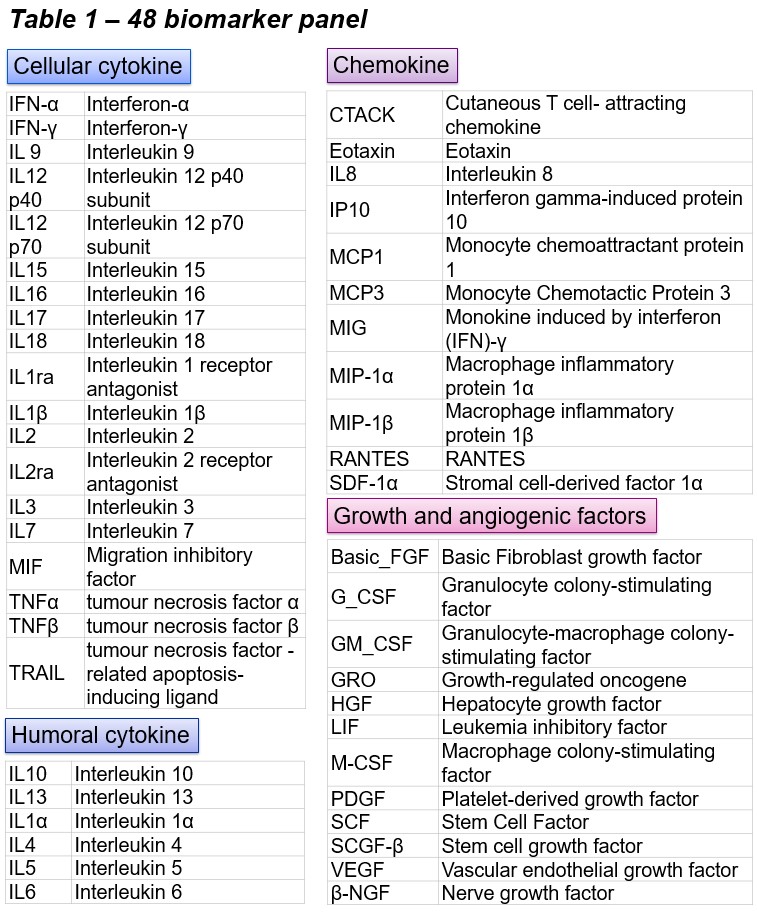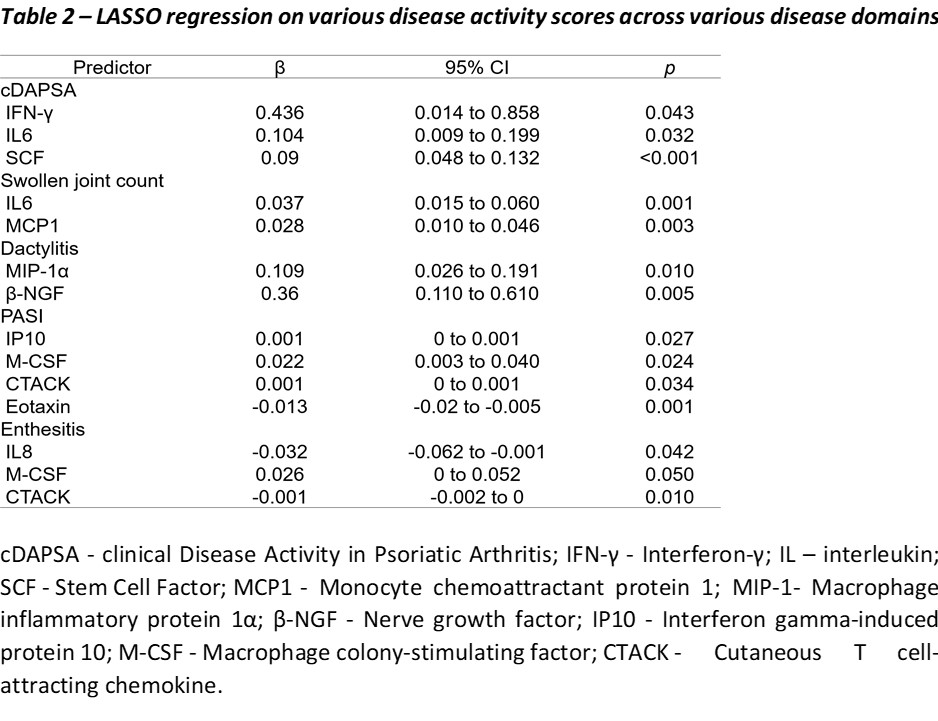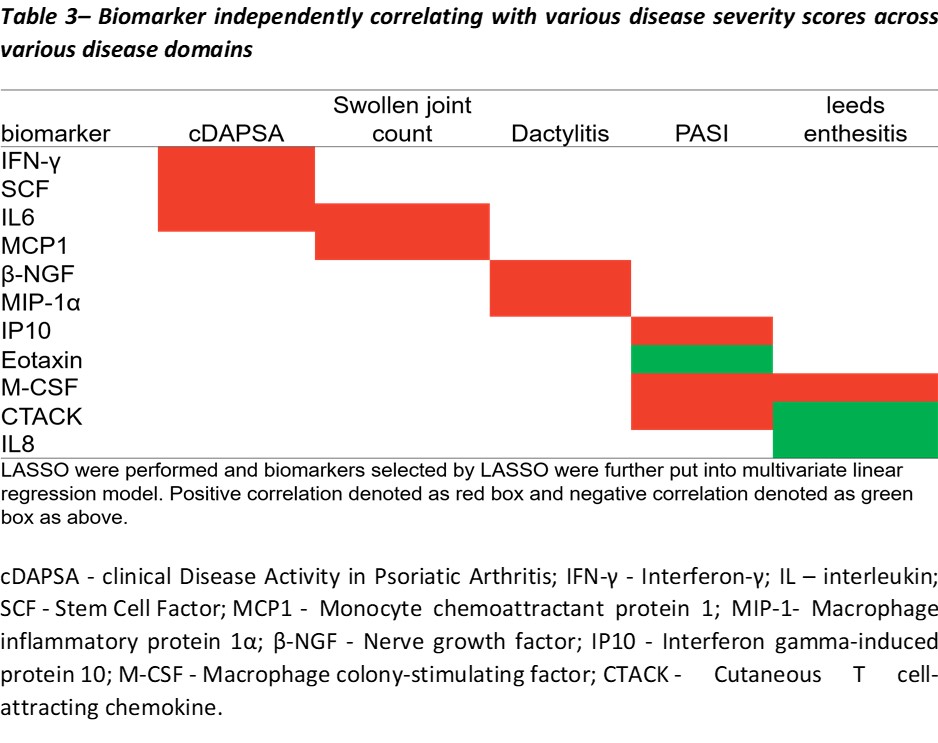Back
Poster Session C
Spondyloarthritis (SpA) including psoriatic arthritis (PsA)
Session: (1486–1517) Spondyloarthritis Including PsA – Diagnosis, Manifestations, and Outcomes Poster III
1501: Comparative Profiling of Serum Protein Biomarkers and Disease Activity Across Various Disease Domains in Patients with Psoriatic Arthritis (PsA)
Sunday, November 13, 2022
1:00 PM – 3:00 PM Eastern Time
Location: Virtual Poster Hall
- IC
Isaac Cheng, PhD
The Chinese University of Hong Kong
Hong Kong, Hong Kong, China
Abstract Poster Presenter(s)
Isaac Cheng1, Martin Li2, Ho SO1, Jack Lee2, Chun Kwok Wong2 and Lai-shan Tam1, 1The Chinese University of Hong Kong, Hong Kong, China, 2The Chinese University of Hong Kong, Hong Kong, Hong Kong
Background/Purpose: Psoriatic Arthritis (PsA) is a complex, heterogeneous disease with chronic inflammation. Disease manifestations include the peripheral joint inflammation, dactylitis, enthesitis and skin psoriasis. Chronic inflammation is associated with structural damage, which jeopardize long-term functional ability. Sensitive biomarkers reflecting disease activity in various disease domains are lacking.
The aim of the study was to define the molecular basis of inflammation in different disease domains through comparative profiling of serum proteins
Methods: This is a cross-sectional study in patients with PsA. Clinical assessment of inflammation in the peripheral joint (clinical Disease Activity in Psoriatic Arthritis [cDAPSA] and swollen joint count), dactylitis digit count, skin (Psoriasis Activity and Severity Index [PASI]) and enthesis (Leeds enthesitis index) were performed. Blood samples were collected for biomarker assay including 48 cytokines, chemokines, growth and angiogenic factors using the Bio-Rad Bioplex assay1 (Table 1). Levels of selected serum proteins were compared between different disease activity scores across various domains using adjusted linear regression with least absolute shrinkage and selection operator (LASSO) modeling.
Results: 100 PsA patients were recruited (age: 51±11 years, male: 52 (52%), disease duration: 9.0±3 years). The cohort had moderate disease activity (DAPSA: 24.4±14.6; PASI: 6.0±7.2). 53 (53%) and 11 (11%) patients were using conventional synthetic disease modifying anti-rheumatic drugs (csDMARDs) and biologic DMARDs (bDMARDs) respectively. Using LASSO regression analysis, biomarkers correlating with peripheral joint inflammation were IFN-γ, IL6, SCF and MCP1, while MIP-1α and β-NGF were related to dactylitis. Biomarkers correlating with skin severity were IP10, M-CSF and eotaxin, while IL8, M-CSF and CTACK were related to enthesitis. Details of biomarkers independent predicting various disease severity are listed in table 2-3.
Conclusion: Comparative serum protein biomarker profiling represents a viable method for distinguishing active inflammation in the various disease domains which may be a step forward towards personalized medicine.
 Table 1 - 48 biomarker panel
Table 1 - 48 biomarker panel
 Table 2 – LASSO regression on various disease activity scores across various disease domains
Table 2 – LASSO regression on various disease activity scores across various disease domains
 Table 3– Biomarker independently correlating with various disease severity scores across various disease domains
Table 3– Biomarker independently correlating with various disease severity scores across various disease domains
Disclosures: I. Cheng, None; M. Li, None; H. SO, None; J. Lee, None; C. Wong, None; L. Tam, AbbVie, Amgen, Boehringer-Ingelheim, Eli Lilly, GlaxoSmithKlein(GSK), Janssen, Novartis, Pfizer, Sanofi, AstraZeneca.
Background/Purpose: Psoriatic Arthritis (PsA) is a complex, heterogeneous disease with chronic inflammation. Disease manifestations include the peripheral joint inflammation, dactylitis, enthesitis and skin psoriasis. Chronic inflammation is associated with structural damage, which jeopardize long-term functional ability. Sensitive biomarkers reflecting disease activity in various disease domains are lacking.
The aim of the study was to define the molecular basis of inflammation in different disease domains through comparative profiling of serum proteins
Methods: This is a cross-sectional study in patients with PsA. Clinical assessment of inflammation in the peripheral joint (clinical Disease Activity in Psoriatic Arthritis [cDAPSA] and swollen joint count), dactylitis digit count, skin (Psoriasis Activity and Severity Index [PASI]) and enthesis (Leeds enthesitis index) were performed. Blood samples were collected for biomarker assay including 48 cytokines, chemokines, growth and angiogenic factors using the Bio-Rad Bioplex assay1 (Table 1). Levels of selected serum proteins were compared between different disease activity scores across various domains using adjusted linear regression with least absolute shrinkage and selection operator (LASSO) modeling.
Results: 100 PsA patients were recruited (age: 51±11 years, male: 52 (52%), disease duration: 9.0±3 years). The cohort had moderate disease activity (DAPSA: 24.4±14.6; PASI: 6.0±7.2). 53 (53%) and 11 (11%) patients were using conventional synthetic disease modifying anti-rheumatic drugs (csDMARDs) and biologic DMARDs (bDMARDs) respectively. Using LASSO regression analysis, biomarkers correlating with peripheral joint inflammation were IFN-γ, IL6, SCF and MCP1, while MIP-1α and β-NGF were related to dactylitis. Biomarkers correlating with skin severity were IP10, M-CSF and eotaxin, while IL8, M-CSF and CTACK were related to enthesitis. Details of biomarkers independent predicting various disease severity are listed in table 2-3.
Conclusion: Comparative serum protein biomarker profiling represents a viable method for distinguishing active inflammation in the various disease domains which may be a step forward towards personalized medicine.
 Table 1 - 48 biomarker panel
Table 1 - 48 biomarker panel Table 2 – LASSO regression on various disease activity scores across various disease domains
Table 2 – LASSO regression on various disease activity scores across various disease domains Table 3– Biomarker independently correlating with various disease severity scores across various disease domains
Table 3– Biomarker independently correlating with various disease severity scores across various disease domainsDisclosures: I. Cheng, None; M. Li, None; H. SO, None; J. Lee, None; C. Wong, None; L. Tam, AbbVie, Amgen, Boehringer-Ingelheim, Eli Lilly, GlaxoSmithKlein(GSK), Janssen, Novartis, Pfizer, Sanofi, AstraZeneca.

